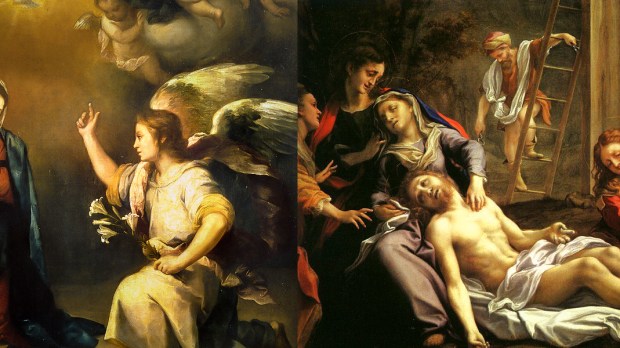This Friday Catholics will all see a cosmic event more rare than any comet or eclipse: Good Friday will fall on March 25. This won’t happen again until 2157. We will commemorate the death of Jesus on the day that falls exactly nine months before Christmas: the day of his conception.
The Church will officially celebrate the Annunciation on April 4 this year instead of March, but that shouldn’t stop us from noticing this unusual occurrence — or hearing the special message it has for us in 2016.
In fact, seeing God joining humanity and being destroyed by humanity on the very same day should speak directly to our times because it speaks to two fundamental attributes of God that we have rejected: his Fatherly and motherly love.
In his encyclical on mercy, St. John Paul II gives great importance to two Old Testament Hebrew words for God’s merciful love: hesed and rahamim.
Hesed is fatherly love. John Paul describes it by way of the father of the Prodigal Son: the father sees himself in his son and so takes full responsibility for him, regardless of his sins. Rahamim is a mother’s love which we also see in God, for instance when he says, “Can a mother forget her infant, be without tenderness for the child of her womb? Even should she forget, I will never forget you” (Isaiah 49:15).
The United States faces a crisis of both fatherhood and motherhood —with an epidemic of fatherlessness at the root of many social ills and one million abortions a year standing as a tragic sign of the radical shift in the value women put on motherhood.
And it is at this crossroads that we find the last March 25 Good Friday for nearly a century and a half.
When these two events coincided in 1608, John Donne wrote a poem about it, seeing the deep contrasts between Christ’s conception and his crucifixion. He looks at it from Mary’s point of view:
“She sees a cedar plant itself, and fall …
“Sad and rejoiced she’s seen at once, and seen
“At almost fifty, and at scarce fifteen ;
“At once a son is promised her, and gone ;
“Gabriel gives Christ to her, He her to John.”
He notes how in the Church God “would join in one/Manhood’s extremes: He shall come, he is gone,” carefully building his poem around a central conclusion: “Death and conception in mankind is one.”
We are temporary. When we appear, we are already on our way to disappearing. This is the message of the March 25 Good Friday, the cruel death that comes so quickly after the quiet beginning.
Nothing good lasts. The idols all crumble. If we think material things will make us happy, we are foolish. If we think a political party or political system will bring about real, lasting justice, we are setting ourselves up for a fall. All that lasts are hesed and rahamim.
On this one March 25 you have the whole Christian story summed up in the story of family relationships, from “the Angel’s Ave” to Mary Christ’s “Consummatum est” to the Father.
In the Annunciation we see the hesed of a Father who comes down the road to meet us, his prodigal children. On Good Friday we see him take so much responsibility for our sins that he takes the punishment onto himself.
And in the Annunciation the Father makes Mary a “mother of mercy,” a channel for God’s rahamim; and then, holding her dead son at the foot of the cross, she becomes an icon of God’s tender care for his people.
St. John Paul II centers his encyclical on mercy around these two images of the Father and the mother.
“Believing in the crucified Son means ‘seeing the Father’; means believing that love is present in the world and that this love is more powerful than any kind of evil in which individuals, humanity, or the world are involved,” he writes.
And “No one has received into his heart, as much as Mary did, that mystery, that truly divine dimension of the redemption effected on Calvary by means of the death of the Son, together with the sacrifice of her maternal heart, together with her definitive ‘fiat.’”
This Friday the Church will kneel before the cross and thank God that this day that marks the beginning and ending of Jesus’ brief life on earth — and the beginning of our eternity in heaven.
Tom Hoopes is writer in residence at Benedictine College in Atchison, Kansas.

